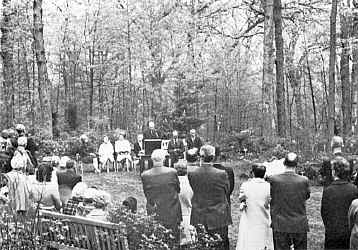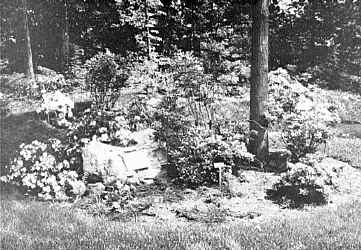Garden Dedication in Honor of Frederic P. Lee
Henry T. Skinner
Director, U. S. National Arboretum, Plant Science Research Division
Agricultural Research Service U. S. Department of Agriculture, Washington, D. C.

|

|
|
FIG: 69. Dr. Knowles Ryerson speaks of
Frederic P. Lee at dedication of Lee Azalea Garden. From left to right - Mrs. Lee, Mrs. Armstrong, Mrs. Bayley, Dr. Irving, Dr. Ryerson, Seth Kelsey, and Dr. Henry Skinner. |
FIG: 70. A portion of the Lee Azalea Garden,
U. S. National Arboretum. Satsuki Azalea 'Sakura-giri' provide a pink background for the edication plaque, with white flowered 'Tatsumi-no-hikari' behind. |
The death of Frederic P. Lee was recorded in the January 1969 issue of the Quarterly Bulletin. Prominent lawyer, horticulturist, author of
The Azalea Book
, and resident of Bethesda, Maryland, Fred Lee was also a longtime chairman of the Advisory Council of the U. S. National Arboretum.
Not long before his quite sudden death, Fred Lee suggested that the Arboretum should choose a cool, semi-shady location for development of a garden to display the best of the late azaleas, the late Glenn Dales, Satsukis, Chugais, and the June-flowering species. In seeking to permanently honor this indefatigable proponent of so many worthwhile causes - social, institutional, and horticultural - it was perhaps natural that his friends of the Advisory Council, the Arboretum, and the community should have elected to initiate the project in which he had been particularly interested.
A site was selected on the wooded north slope of the National Arboretum's Mt. Hamilton, on the opposite side from the well known mass plantings of Glenn Dale azaleas. A garden was designed by Seth L. Kelsey, Council member of Stamford, Connecticut. Grading was undertaken during the summer of 1970, and major planting was completed during the spring of 1971. Contributions from many of Mr. Lee's friends, and from the Montgomery County Men's Garden Club in which he had long been active, provided many of the plants and features. Four benches, imported from England, were placed in the garden for the enjoyment of visitors in memory of the late Stuart M. Armstrong, another ARS member and friend-in-azaleas of both Fred Lee and B. Y. Morrison, originator of the Glenn Dale hybrids.
The new Lee Garden of late azaleas was dedicated on April 30, 1971, in the presence of the National Arboretum Advisory Council and many friends of the Lee and Armstrong families. Dr. George W. Irving, Administrator of the Agricultural Research Service, U. S. Department of Agriculture, served as Master of Ceremonies; Dr. Knowles A. Ryerson, Dean Emeritus of the University of California, spoke of the life and contributions of Mr. Lee; the writer of this note described the somewhat parallel interests of Mr. Armstrong; and Mr. Seth L. Kelsey drew attention to some of the main plants and features of the garden. The ceremony concluded with the unveiling of a bronze plaque and presentation of the benches by Mrs. Ned D. Bayley, wife of the Department of Agriculture's Director of Science and Education. It was a pleasant day beneath the tall oaks and tulip trees at a time when eastern dogwoods formed a curtain of white above the bright colors of adjacent plantings of azaleas and rhododendrons.
The site of the Lee Garden is at the northern end of the Arboretum's Azalea Loop Trail which displays some 1,900 varieties of evergreen azaleas grouped by colors. Patterned in the naturalistic flavor of Mr. Lee's home plantings, the new garden focuses upon a central lawn area with small spring-fed pond on the lower side. Surfaced with shredded oak bark, surrounding pathways connect with the nearby collection of Dexter rhododendrons and with a new main walk, yet to be planted, which will provide an approach to the Azalea Loop Trail from vicinity of the Arboretum's Administration Building.
As designed by Mr. Kelsey, the garden especially features Chugai, Satsuki, Hirado, late Glenn Dale and Nakaharai hybrid azaleas, but not to the exclusion of longer seasonal interest. An interweaving of other evergreen and deciduous azaleas will provide color accents against background groupings of hemlock, hollies, rhododendrons, clethra, gordonia, and dogwoods. Some of these, including a fine 12-foot specimen of Ilex 'Father Charles', were contributed by Mrs. Lee from the home garden, with promise of a series of Fred Lee's favorite groundcovers in hostas, epimediums, etc., to be available for fall planting. Other plant-growing friends have been equally generous with their gifts.
The June azalea show was excellent, even this first year, and with its several benches made of English elm in comfortable but informal design, the Lee Garden has already become a favored spot for education, for relaxation, and enjoyment.